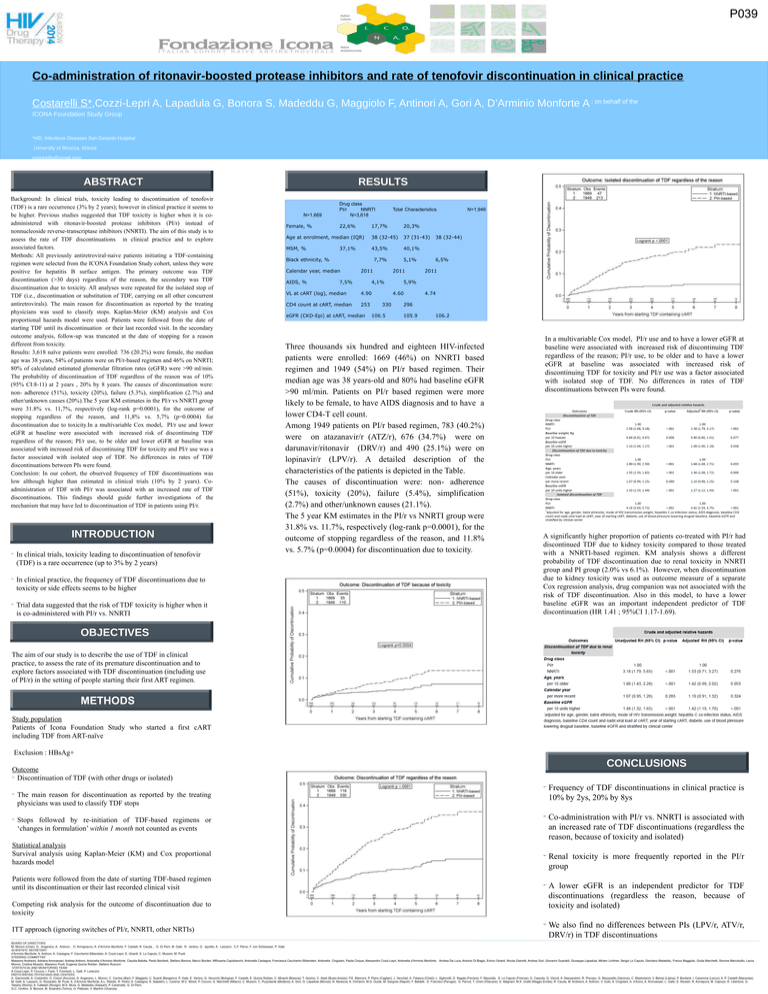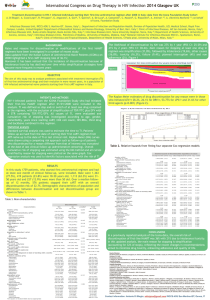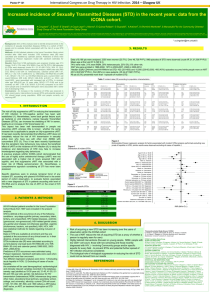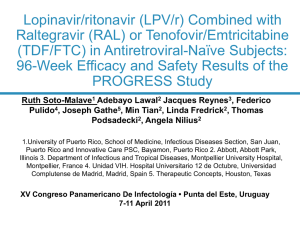Co-administration of ritonavir-boosted protease inhibitors and rate of
advertisement

P039 Co-administration of ritonavir-boosted protease inhibitors and rate of tenofovir discontinuation in clinical practice Costarelli S*,Cozzi-Lepri A, Lapadula G, Bonora S, Madeddu G, Maggiolo F, Antinori A, Gori A, D’Arminio Monforte A ; on behalf of the ICONA Foundation Study Group *MD, Infectious Diseases San Gerardo Hospital University of Bicocca, Monza costarellis@gmail.com ABSTRACT Background: In clinical trials, toxicity leading to discontinuation of tenofovir (TDF) is a rare occurrence (3% by 2 years); however in clinical practice it seems to be higher. Previous studies suggested that TDF toxicity is higher when it is coadministered with ritonavir-boosted protease inhibitors (PI/r) instead of nonnucleoside reverse-transcriptase inhibitors (NNRTI). The aim of this study is to assess the rate of TDF discontinuations in clinical practice and to explore associated factors. Methods: All previously antiretroviral-naive patients initiating a TDF-containing regimen were selected from the ICONA Foundation Study cohort, unless they were positive for hepatitis B surface antigen. The primary outcome was TDF discontinuation (>30 days) regardless of the reason, the secondary was TDF discontinuation due to toxicity. All analyses were repeated for the isolated stop of TDF (i.e., discontinuation or substitution of TDF, carrying on all other concurrent antiretrovirals). The main reason for discontinuation as reported by the treating physicians was used to classify stops. Kaplan-Meier (KM) analysis and Cox proportional hazards model were used. Patients were followed from the date of starting TDF until its discontinuation or their last recorded visit. In the secondary outcome analysis, follow-up was truncated at the date of stopping for a reason different from toxicity. Results: 3,618 naïve patients were enrolled: 736 (20.2%) were female, the median age was 38 years, 54% of patients were on PI/r-based regimen and 46% on NNRTI; 80% of calculated estimated glomerular filtration rates (eGFR) were >90 ml/min. The probability of discontinuation of TDF regardless of the reason was of 10% (95% CI:8-11) at 2 years , 20% by 8 years. The causes of discontinuation were: non- adherence (51%), toxicity (20%), failure (5.3%), simplification (2.7%) and other/unknown causes (20%).The 5 year KM estimates in the PI/r vs NNRTI group were 31.8% vs. 11,7%, respectively (log-rank p=0.0001), for the outcome of stopping regardless of the reason, and 11,8% vs. 5,7% (p=0.0004) for discontinuation due to toxicity.In a multivariable Cox model, PI/r use and lower eGFR at baseline were associated with increased risk of discontinuing TDF regardless of the reason; PI/r use, to be older and lower eGFR at baseline was associated with increased risk of discontinuing TDF for toxicity and PI/r use was a factor associated with isolated stop of TDF. No differences in rates of TDF discontinuations between PIs were found. Conclusion: In our cohort, the observed frequency of TDF discontinuations was low although higher than estimated in clinical trials (10% by 2 years). Coadministration of TDF with PI/r was associated with an increased rate of TDF discontinuations. This findings should guide further investigations of the mechanism that may have led to discontinuation of TDF in patients using PI/r. INTRODUCTION In clinical trials, toxicity leading to discontinuation of tenofovir (TDF) is a rare occurrence (up to 3% by 2 years) In clinical practice, the frequency of TDF discontinuations due to toxicity or side effects seems to be higher Trial data suggested that the risk of TDF toxicity is higher when it is co-administered with PI/r vs. NNRTI RESULTS N=1,669 Female, % Drug class PI/r NNRTI N=3,618 22,6% Total Characteristics 17,7% 20,3% Age at enrolment, median (IQR) 38 (32-45) 37 (31-43) MSM, % 43,5% 40,1% 37,1% Black ethnicity, % 7,7% Calendar year, median AIDS, % 2011 7,5% 2011 4,1% VL at cART (log), median 4.90 CD4 count at cART, median 253 eGFR (CKD-Epi) at cART, median 5,1% 106.5 38 (32-44) 6,5% 2011 5,9% 4.60 330 N=1,949 4.74 296 105.9 106.2 Three thousands six hundred and eighteen HIV-infected patients were enrolled: 1669 (46%) on NNRTI based regimen and 1949 (54%) on PI/r based regimen. Their median age was 38 years-old and 80% had baseline eGFR >90 ml/min. Patients on PI/r based regimen were more likely to be female, to have AIDS diagnosis and to have a lower CD4-T cell count. Among 1949 patients on PI/r based regimen, 783 (40.2%) were on atazanavir/r (ATZ/r), 676 (34.7%) were on darunavir/ritonavir (DRV/r) and 490 (25.1%) were on lopinavir/r (LPV/r). A detailed description of the characteristics of the patients is depicted in the Table. The causes of discontinuation were: non- adherence (51%), toxicity (20%), failure (5.4%), simplification (2.7%) and other/unknown causes (21.1%). The 5 year KM estimates in the PI/r vs NNRTI group were 31.8% vs. 11.7%, respectively (log-rank p=0.0001), for the outcome of stopping regardless of the reason, and 11.8% vs. 5.7% (p=0.0004) for discontinuation due to toxicity. In a multivariable Cox model, PI/r use and to have a lower eGFR at baseline were associated with increased risk of discontinuing TDF regardless of the reason; PI/r use, to be older and to have a lower eGFR at baseline was associated with increased risk of discontinuing TDF for toxicity and PI/r use was a factor associated with isolated stop of TDF. No differences in rates of TDF discontinuations between PIs were found. A significantly higher proportion of patients co-treated with PI/r had discontinued TDF due to kidney toxicity compared to those treated with a NNRTI-based regimen. KM analysis shows a different probability of TDF discontinuation due to renal toxicity in NNRTI group and PI group (2.0% vs 6.1%). However, when discontinuation due to kidney toxicity was used as outcome measure of a separate Cox regression analysis, drug companion was not associated with the risk of TDF discontinuation. Also in this model, to have a lower baseline eGFR was an important independent predictor of TDF discontinuation (HR 1.41 ; 95%CI 1.17-1.69). OBJECTIVES The aim of our study is to describe the use of TDF in clinical practice, to assess the rate of its premature discontinuation and to explore factors associated with TDF discontinuation (including use of PI/r) in the setting of people starting their first ART regimen. METHODS Study population Patients of Icona Foundation Study who started a first cART including TDF from ART-naïve Exclusion : HBsAg+ CONCLUSIONS Outcome Discontinuation of TDF (with other drugs or isolated) Frequency of TDF discontinuations in clinical practice is 10% by 2ys, 20% by 8ys Co-administration with PI/r vs. NNRTI is associated with an increased rate of TDF discontinuations (regardless the reason, because of toxicity and isolated) Statistical analysis Survival analysis using Kaplan-Meier (KM) and Cox proportional hazards model Renal toxicity is more frequently reported in the PI/r group Patients were followed from the date of starting TDF-based regimen until its discontinuation or their last recorded clinical visit A lower eGFR is an independent predictor for TDF discontinuations (regardless the reason, because of toxicity and isolated) We also find no differences between PIs (LPV/r, ATV/r, DRV/r) in TDF discontinuations The main reason for discontinuation as reported by the treating physicians was used to classify TDF stops Stops followed by re-initiation of TDF-based regimens or ‘changes in formulation’ within 1 month not counted as events Competing risk analysis for the outcome of discontinuation due to toxicity ITT approach (ignoring switches of PI/r, NNRTI, other NRTIs) BOARD OF DIRECTORS M. Moroni (Chair), G. Angarano, A. Antinori, , O. Armignacco, A. d’Arminio Monforte, F. Castelli, R. Cauda, , G. Di Perri, M. Galli, R. Iardino, G. Ippolito, A. Lazzarin, C.F. Perno, F. von Schloesser, P. Viale SCIENTIFIC SECRETARY d’Arminio Monforte, A. Antinori, A. Castagna, F. Ceccherini-Silberstein, A. Cozzi-Lepri, E. Girardi, S. Lo Caputo, C. Mussini, M. Puoti STEERING COMMITTEE Massimo Andreoni, Adriana Ammassari, Andrea Antinori, Antonella d’Arminio Monforte, Claudia Balotta, Paolo Bonfanti, Stefano Bonora, Marco Borderi, MRosaria Capobianchi, Antonella Castagna, Francesca Ceccherini-Silberstein, Antonella Cingolani, Paola Cinque, Alessandro Cozzi-Lepri, Antonella d’Arminio Monforte, Andrea De Luca, Antonio Di Biagio, Enrico Girardi, Nicola Gianotti, Andrea Gori, Giovanni Guaraldi, Giuseppe Lapadula, Miriam Lichtner, Sergio Lo Caputo, Giordano Madeddu, Franco Maggiolo, Giulia Marchetti, Simone Marcotullio, Laura Monno, Cristina Mussini, Massimo Puoti, Eugenia Quiros Roldan, Stefano Rusconi STATISTICAL AND MONITORING TEAM A.Cozzi-Lepri, P. Cicconi, I. Fanti, T. Formenti, L. Galli, P. Lorenzini PARTICIPATING PHYSICIANS AND CENTERS A. Giacometti, A. Costantini, O. Cirioni (Ancona); G. Angarano, L. Monno, C. Carrisa (Bari); F. Maggiolo, C. Suardi (Bergamo); P. Viale, E. Vanino, G. Verucchi (Bologna); F. Castelli, E. Quiros Roldan, C. Minardi (Brescia); T. Quirino, C. Abeli (Busto Arsizio); P.E. Manconi, P. Piano (Cagliari); J. Vecchiet, K. Falasca (Chieti); L. Sighinolfi, D. Segala (Ferrara); F. Mazzotta, S. Lo Caputo (Firenze); G. Cassola, G. Viscoli, A. Alessandrini, R. Piscopo, G. Mazzarello (Genova); C. Mastroianni, V. Belvisi (Latina); P. Bonfanti, I. Caramma (Lecco); A. P. Castelli (Macerata); M. Galli, A. Lazzarin, G. Rizzardini, M. Puoti, A. d’Arminio Monforte, A.L. Ridolfo, R. Piolini, A. Castagna, S. Salpietro, L. Carenzi, M.C. Moioli, P. Cicconi, G. Marchetti (Milano); C. Mussini, C. Puzzolante (Modena); A. Gori, G. Lapadula (Monza); N. Abrescia, A. Chirianni, M.G. Guida, M. Gargiulo (Napoli); F. Baldelli, D. Francisci (Perugia); G. Parruti, T. Ursini (Pescara); G. Magnani, M.A. Ursitti (Reggio Emilia); R. Cauda, M. Andreoni, A. Antinori, V. Vullo, A. Cingolani, A. d’Avino, A. Ammassari, L. Gallo, E. Nicastri, R. Acinapura, M. Capozzi, R. Libertone, G. Tebano (Roma); A. Cattelan (Rovigo); M.S. Mura, G. Madeddu (Sassari); P. Caramello, G. Di Perri, G.C. Orofino, S. Bonora, M. Sciandra (Torino); G. Pellizzer, V. Manfrin (Vicenza).



